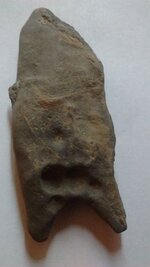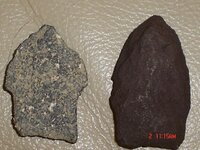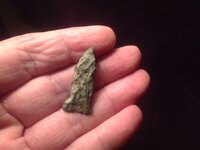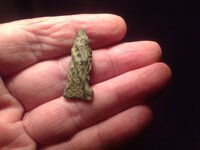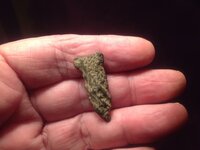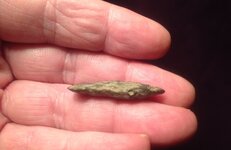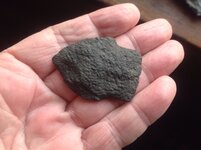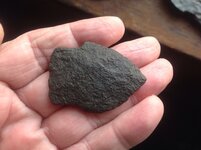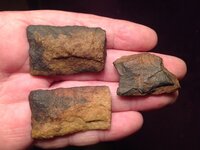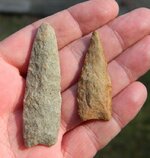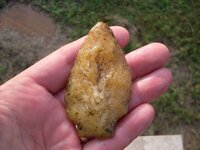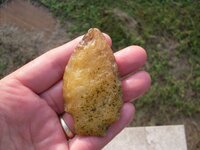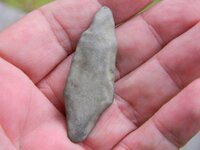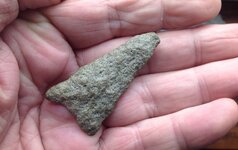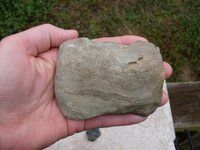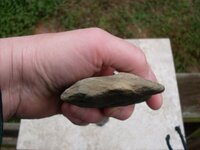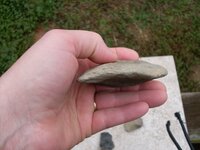Navigation
Install the app
How to install the app on iOS
Follow along with the video below to see how to install our site as a web app on your home screen.
Note: This feature may not be available in some browsers.
More options
You are using an out of date browser. It may not display this or other websites correctly.
You should upgrade or use an alternative browser.
You should upgrade or use an alternative browser.
both sides of point -fluted? any help would be great
- Thread starter green horn
- Start date
green horn
Greenie
- Thread starter
- #21
thank you my gut and eyes were telling me its a point any suggestions were I could bring it to confirm gtp
Amazon Forum Fav 👍
It has the shape of a paleo point but I have found rocks that I thought looked like a artifact but after checking it over I knew it was a geofact I have been hunting Indian artifacts for 30 years & I don't see an arrowhead there it's a geofact!
rock
Gold Member
You would have to soak it in something before I can say its a point. Even if it had mineral deposits on it there should be some kind of flaking that shows. I see none, nothing that says artifact. Geofact imo
green horn
Greenie
- Thread starter
- #24
what should I soak it in
Get-the-point
Bronze Member
You would have to soak it in something before I can say its a point. Even if it had mineral deposits on it there should be some kind of flaking that shows. I see none, nothing that says artifact. Geofact imo
Rock... this type of stone could easily be ground. The material is so soft, when i clean the points with a soft toothbrush the water turns the color of the argillite. I'll try and video it.....it will be a first at posting one but I will see what i can do. I've asked to see it first hand then I'll know for sure.
Get-the-point
Bronze Member
Get-the-point
Bronze Member
quito
Silver Member
Taint no airy head. I Have never seen a 3 inch plus "arrowhead". LOL.
C'mon boys, we may not be able to identify everything, but we do know our terminology better than that, and where size limits apply to such things.
It more Resembles a classic lanceolate imho.
C'mon boys, we may not be able to identify everything, but we do know our terminology better than that, and where size limits apply to such things.
It more Resembles a classic lanceolate imho.
justonemore
Sr. Member
No way. I for one dislike being an armchair authenticator based on photos posted on a forum but occasionally you got to say what needs to be said. To believe that is a paleo artifact because of the few attributes that are perceived is another instance of folks seeing what they want to see.
Charl
Silver Member
Our New England argillite, while a very poor material, does not weather as poorly as the argillite from south of us. I do have points that are "completely erased", the flaking entirely gone. We've had threads on here before about that subject. But, for now, here's my best example of a point made from that grainier argillite from south of New England. I'm sure many will also say "that is not a point". But, as far as I am concerned, yes it is. You can see a couple of tiny flakes removed from around the base. But the point itself is so weathered, it even shows differential weathering. Those lines or ridges are harder material, with softer material between them. So I am not saying the piece in question in this thread is a Paleo point, they did almost always choose to use high grade material, not something as poor as NJ/Pa argillite, but here is a point that I suspect most people would leave in the sands, assuming it's no point at all. And it's an example of just how absolutely crappy this stuff really is. I can show you points made of New England argillite that are not ground into shape, but show no flaking left whatsoever. I came to calling them "erased points", points on their way to becoming geofacts in appearance. But this stuff here actually shows differential weathering, and nobody could be blamed for concluding it is not a point. But 60 years of experience picking up crappy material tells me different....
Attachments
Last edited:
Charl
Silver Member
If our crappy slate-like New England argillite can have all flaking erased through weathering, I do believe the even crappier shale-like argillite from further south can as well. To this day, my wife refuses to believe this is even a point. But I do maintain it is a Fox Creek Stemmed, made of NJ/Pa argillite, all flaking weathered away, showing only a coarsely grained stone in the shape of a point. But, it's no geofact. It's what's left of a Fox Creek made of very poor argillaceous shale. New England argillite, in contrast, is argillaceous slate. Both are varieties that collectors just call argillite, even though, technically, one is argillaceous slate, and the other is argillaceous shale. Both readily weather to a point where they become what I took to calling "erased points" on their way to looking like geofacts.
Again, I am not saying that is the case with the piece at the center of this thread. But I am saying I know exactly where Get The Point is coming from. I understand that he has the same understanding that I do where weathering and argillite is concerned. However, mjm has a valid point in pointing out the Early Paleo hunters just did not select low grade material. Almost all our fluted points from New England, for instance, are fashioned from quality cherts/jaspers obtained at a great distance. The Paleo hunters, at least the fluted point people, did not select locally obtained crappy material.
Again, I am not saying that is the case with the piece at the center of this thread. But I am saying I know exactly where Get The Point is coming from. I understand that he has the same understanding that I do where weathering and argillite is concerned. However, mjm has a valid point in pointing out the Early Paleo hunters just did not select low grade material. Almost all our fluted points from New England, for instance, are fashioned from quality cherts/jaspers obtained at a great distance. The Paleo hunters, at least the fluted point people, did not select locally obtained crappy material.
Attachments
PaJim
Full Member
- Dec 13, 2015
- 106
- 112
- Detector(s) used
- Land Ranger Pro
Whites coinmaster
Garret AT Propointer
- Primary Interest:
- All Treasure Hunting
No one is talking about the shape of the point. When I look at images of paleo points, they are fairly symmetrical. This one seems way off and very crude. Perhaps someone was practicing and or learning to knap and this was the result? Whats the deal with the circular impressions?
Sent from my N800 using Tapatalk
Sent from my N800 using Tapatalk
Get-the-point
Bronze Member
Mjm....I completely agree on paleo mans use of high quality materials but have seen paleo lance points made of Argillite. So i would have to imagine that when gathering... all usable materials would be utilized. Here is a paleo example made of Argillite found in Pa......
found in Pa......
PaJim ...Form would have been there if the impact break did not occur. The three potholes in the piece was most likely from water. Hopefully I get to see this piece to know for sure but from what i see it is most likely a lance point. The blade edges are there, the tip is almost all there and base is there....I see complete form here.....the second set of photos really showed the form......again the pics are not perfect but if i get to see it I will know and post better pics of it.
 found in Pa......
found in Pa......PaJim ...Form would have been there if the impact break did not occur. The three potholes in the piece was most likely from water. Hopefully I get to see this piece to know for sure but from what i see it is most likely a lance point. The blade edges are there, the tip is almost all there and base is there....I see complete form here.....the second set of photos really showed the form......again the pics are not perfect but if i get to see it I will know and post better pics of it.
Last edited:
Charl
Silver Member
Just for the record here, once you get to the Late Paleo folks, more local lithics do indeed come into play. I found several bases of Ste. Anne-Varney points this year, made of a more regional quartzite, that continued to be used into Archaic times. But, for Early Paleo, good quality lithics was almost always the rule. Not so by the time period of Late Paleo lances.
Here are three Late Paleo/Early Archaic bases. The one with concave base was identified by Dr. Gramly as likely Dalton related. The other two are Late Paleo Ste. Anne-Varney lances, roughly 11,000 calender years BP. Made of a lower grade quartzite, and River stained. By Late Paleo, here in New England, the people were settling in, and made less use of quality lithics obtained at a distance. Early Paleo seldom strayed from higher quality lithics.
The complete examples are Late Paleo lances, also made of quartzite, and found by a friend at the same early encampment as the bases I found recently.....
Here are three Late Paleo/Early Archaic bases. The one with concave base was identified by Dr. Gramly as likely Dalton related. The other two are Late Paleo Ste. Anne-Varney lances, roughly 11,000 calender years BP. Made of a lower grade quartzite, and River stained. By Late Paleo, here in New England, the people were settling in, and made less use of quality lithics obtained at a distance. Early Paleo seldom strayed from higher quality lithics.
The complete examples are Late Paleo lances, also made of quartzite, and found by a friend at the same early encampment as the bases I found recently.....
Attachments
Last edited:
rock
Gold Member
I am full aware of points with erased flaking I have some but just the dimples at the "base" says natural to me. I wish I had kept one point I found that was a perfect example of erased flaking but I figured nobody would believe such a thing and I tossed it back into the drink last year. But yes I have others like this one. Quartzite wears down while in current for many years. I dont disagree with erased points. I just dont see it in this one posted as anything more than a cool shaped rock..
My biggest whole point I have ever found by the way.
My biggest whole point I have ever found by the way.
Attachments
Charl
Silver Member
I thought the dimples at the "base" were problems as well. Unless they are water worn pot lids, although that may very well be a heck of a stretch. But a water worn pot lid would resemble a dimple. And if it were in the Dalton family, and not Early Paleo, it could be made of crappy material.
if I found a very water worn point, and knew it was a point, the very last thing I would do is toss it out of concern that other people would not believe me. Why in the world would I care what other people thought?? If I knew it was a point, that would be all that mattered, and I would collect it. Not throw it away because I was afraid nobody else would believe it. What would that say about the courage of my convictions? Throwing a point away because nobody would believe it?? Shame on me if that was a reason to throw away an actual projectile point. Throw away because it was not up to my quality standards, maybe, if that's how I feel, but otherwise to heck with what others might think. Who cares??
Here's what a New England argillite point(argillaceous slate)looks like when "erased" by water. I was not afraid to keep it, either. I was not really concerned if anyone believed me. I collect points when I find them. It would not go in my "best" frame, that's for sure, but it would be a part of the site assemblage, and, as such, collected and saved. I don't collect points based on what others think. I can't imagine myself thinking "I know this is a point, but nobody will agree, so back in the drink she goes". Strange decision to say the least, IMO. I find a piece of prehistory, I keep it. Other people can think whatever they want.
So this is argillaceous slate, for comparison to a piece of argillaceous shale. It's a Middle Archaic Stark point, in the 7000-8000 year range, and very water worn "erased".
And, since quartzite was brought up, the other point seen here, with a tiny tip ding, is a great example of a Late Archaic Brewerton Eared Triangle, flaking erased, leaving only a very poor quality grainy quartzite in the shape of a Brewerton point. I know it's a point. I am not surprised, however, when folks not accustomed to finding such poorly preserved points, express reservations. That's there right, but I don't really care or belabor the point. They are entitled to their opinion, and I have all the confidence in the world in my identification....
if I found a very water worn point, and knew it was a point, the very last thing I would do is toss it out of concern that other people would not believe me. Why in the world would I care what other people thought?? If I knew it was a point, that would be all that mattered, and I would collect it. Not throw it away because I was afraid nobody else would believe it. What would that say about the courage of my convictions? Throwing a point away because nobody would believe it?? Shame on me if that was a reason to throw away an actual projectile point. Throw away because it was not up to my quality standards, maybe, if that's how I feel, but otherwise to heck with what others might think. Who cares??
Here's what a New England argillite point(argillaceous slate)looks like when "erased" by water. I was not afraid to keep it, either. I was not really concerned if anyone believed me. I collect points when I find them. It would not go in my "best" frame, that's for sure, but it would be a part of the site assemblage, and, as such, collected and saved. I don't collect points based on what others think. I can't imagine myself thinking "I know this is a point, but nobody will agree, so back in the drink she goes". Strange decision to say the least, IMO. I find a piece of prehistory, I keep it. Other people can think whatever they want.
So this is argillaceous slate, for comparison to a piece of argillaceous shale. It's a Middle Archaic Stark point, in the 7000-8000 year range, and very water worn "erased".
And, since quartzite was brought up, the other point seen here, with a tiny tip ding, is a great example of a Late Archaic Brewerton Eared Triangle, flaking erased, leaving only a very poor quality grainy quartzite in the shape of a Brewerton point. I know it's a point. I am not surprised, however, when folks not accustomed to finding such poorly preserved points, express reservations. That's there right, but I don't really care or belabor the point. They are entitled to their opinion, and I have all the confidence in the world in my identification....
Attachments
Last edited:
rock
Gold Member
I have this one to which I have taken to shows everyone says yes on it but nobody says just what it is for sure without doubt. I have heard peanut ax all the way to preform banner. I think its made from some kind of water worn green stone. When this artifact was 1st made Im sure the stone would of been much harder but after years of being in a creek with current and water temps from freezing to warm the material has started to break down. But it still shows work on it.
Attachments
rock
Gold Member
I thought the dimples at the "base" were problems as well. Unless they are water worn pot lids, although that may very well be a heck of a stretch. But a water worn pot lid would resemble a dimple. And if it were in the Dalton family, and not Early Paleo, it could be made of crappy material.
if I found a very water worn point, and knew it was a point, the very last thing I would do is toss it out of concern that other people would not believe me. Why in the world would I care what other people thought?? If I knew it was a point, that would be all that mattered, and I would collect it. Not throw it away because I was afraid nobody else would believe it. What would that say about the courage of my convictions? Throwing a point away because nobody would believe it?? Shame on me if that was a reason to throw away an actual projectile point. Throw away because it was not up to my quality standards, maybe, if that's how I feel, but otherwise to heck with what others might think. Who cares??
Here's what a New England argillite point(argillaceous slate)looks like when "erased" by water. I was not afraid to keep it, either. I was not really concerned if anyone believed me. I collect points when I find them. It would not go in my "best" frame, that's for sure, but it would be a part of the site assemblage, and, as such, collected and saved. I don't collect points based on what others think. I can't imagine myself thinking "I know this is a point, but nobody will agree, so back in the drink she goes". Strange decision to say the least, IMO. I find a piece of prehistory, I keep it. Other people can think whatever they want.
So this is argillaceous slate, for comparison to a piece of argillaceous shale. It's a Middle Archaic Stark point, in the 7000-8000 year range, and very water worn "erased".
And, since quartzite was brought up, the other point seen here, with a tiny tip ding, is a great example of a Late Archaic Brewerton Eared Triangle, flaking erased, leaving only a very poor quality grainy quartzite in the shape of a Brewerton point. I know it's a point. I am not surprised, however, when folks not accustomed to finding such poorly preserved points, express reservations. That's there right, but I don't really care or belabor the point. They are entitled to their opinion, and I have all the confidence in the world in my identification....
I had no idea such a thing could be possible. That is why I tossed it.
Top Member Reactions
-
 3383
3383 -
 2001
2001 -
 1933
1933 -
 1164
1164 -
 1097
1097 -
 890
890 -
 806
806 -
 797
797 -
 794
794 -
 787
787 -
 745
745 -
 537
537 -
 482
482 -
 460
460 -
 444
444 -
 422
422 -
 422
422 -
 420
420 -
E
409
-
 383
383
Users who are viewing this thread
Total: 2 (members: 0, guests: 2)




